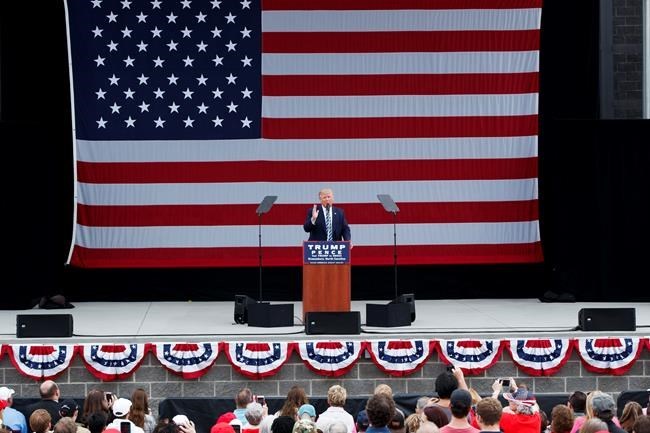
Republican presidential candidate Donald Trump speaks during a campaign rally, Friday, Oct. 14, 2016, in Greensboro, N.C. (AP Photo/ Evan Vucci)
October 14, 2016 - 12:28 PM
ATLANTA - In the final weeks of his presidential campaign, Donald Trump is countering allegations of his own sexual misconduct by recounting accusations against former President Bill Clinton.
The basic idea: If the Republican nominee cannot expand his coalition enough to win, might he be able to leave enough voters so disgusted with both himself and Democrat Hillary Clinton that they opt for third-party candidates or simply don't vote?
If so, might Trump's core supporters — smaller than the usual winning coalition — be enough to nip Clinton?
Early voting numbers, Democratic enthusiasm and historical trends all suggest Trump cannot win this way.
"Any strategy of trying to drive down turnout in a democratic election is not the most noble of motivations to begin with," said Republican pollster Whit Ayres. "And there's just no chance for it work."
Democrats are taking no chances. First lady Michelle Obama told a raucous crowd Thursday in New Hampshire: "We cannot allow ourselves to be so disgusted that we just shut off the TV and look away." President Barack Obama himself warned Friday in Cleveland, Ohio, that Trump wanted them to believe they have "no good choices" and opt against voting.
"Don't fall for it," he said.
___
TRUMP'S STRUGGLES
Well before Trump won the nomination, Republicans assumed their standard-bearer could start with a baseline of what Mitt Romney won four years ago (61 million votes), then pull in additional independents unsettled by the notion of a third consecutive Democratic term.
Meanwhile, they figured Clinton would struggle to generate Obama's level of support among nonwhites and young voters. The Republican nominee could then close the gap in enough swing states to capture the 270 electoral votes needed to win.
Trump's has failed at the first task: maintaining Romney's coalition. College-educated women are the biggest reason why, and that was before last week's revelations of a 2005 video showing Trump bragging about groping and kissing women without their permission.
Applying recent polls to an electorate of 130 million (about what it's been the last two elections), Clinton would top 62 million votes to Trump's 54 million or so, giving Clinton a comfortable Electoral College majority.
___
TRUMP'S APPROACH
Trump doesn't explicitly say he wants low voter turnout. But since the video was released, he's done little to reach out to moderate Republicans and independents. He's explained his remarks as "locker-room talk," and sought to inflame his anti-establishment base, casting the race as "a struggle for the survival of our nation."
He's slammed Bill Clinton, highlighting women who've made unproven allegations of sexual assault against the former president. He's claimed Hillary Clinton was complicit in her husband's actions.
Trump alleges American media and corporate powers are in cahoots with the Clintons and against him.
Allegations of women who said he made unwanted sexual advances are "lies," Trump insists, and "a coverup" of his opponent's crimes is intended "to keep the Clintons in power."
Roger Stone, a longtime Trump friend, explained the candidate's emphasis.
Hillary Clinton's candidacy "has been based on the premise that she is this great advocate for women and children," Stone said. But he told the AP that voters will desert her when they realize she has "terrorized" women.
Steve Schale, a Democratic strategist, said this approach reflects a "cratering" candidate desperate to "bring his opponent down with him."
___
TOUGH MATH
Analysts say Trump can't win by driving down turnout.
Democratic pollster Paul Maslin said Trump would have to pull down Clinton by 8 million to 10 million votes. "That defies logic," he said.
Ayres, the Republican pollster, said elections that are "reasonably close" and involve "clear consequences" usually generate higher turnout. "I'd say this election meets both standards," he said.
Presidential turnout in 2012 was about 129 million, down from about 131 million in 2008. Still, turnout generally has climbed over time alongside population growth. Voter registration isn't yet complete, but population figures suggest normal turnout will again top 130 million.
"We will see more votes cast in this election than ever before," said Clinton campaign manager Robby Mook.
Early voting is on the rise, with Clinton's campaign pushing supporters in that direction. More than 750,000 ballots have been cast already, and an estimated 45 million votes are expected before Election Day. Early-voting trends in two must-win states for Trump, North Carolina and Florida, are favourable to Clinton. In both states, there are notable gains among black and Hispanic voters, groups Trump needs to remain cool to Clinton.
The Republican National Committee and individual Senate and House campaigns also have an extensive "ground game" of staffers and volunteers working to identify and encourage supporters. So has the political network of the Koch brothers, the conservative billionaire businessmen.
Polls suggest at least some of those voters will vote for Clinton.
___
Associated Press reporters Julie Bykowicz, Josh Lederman in Cleveland and Jonathan Lemire in New York contributed. Follow Barrow on Twitter at https://twitter.com/BillBarrowAP
News from © The Associated Press, 2016